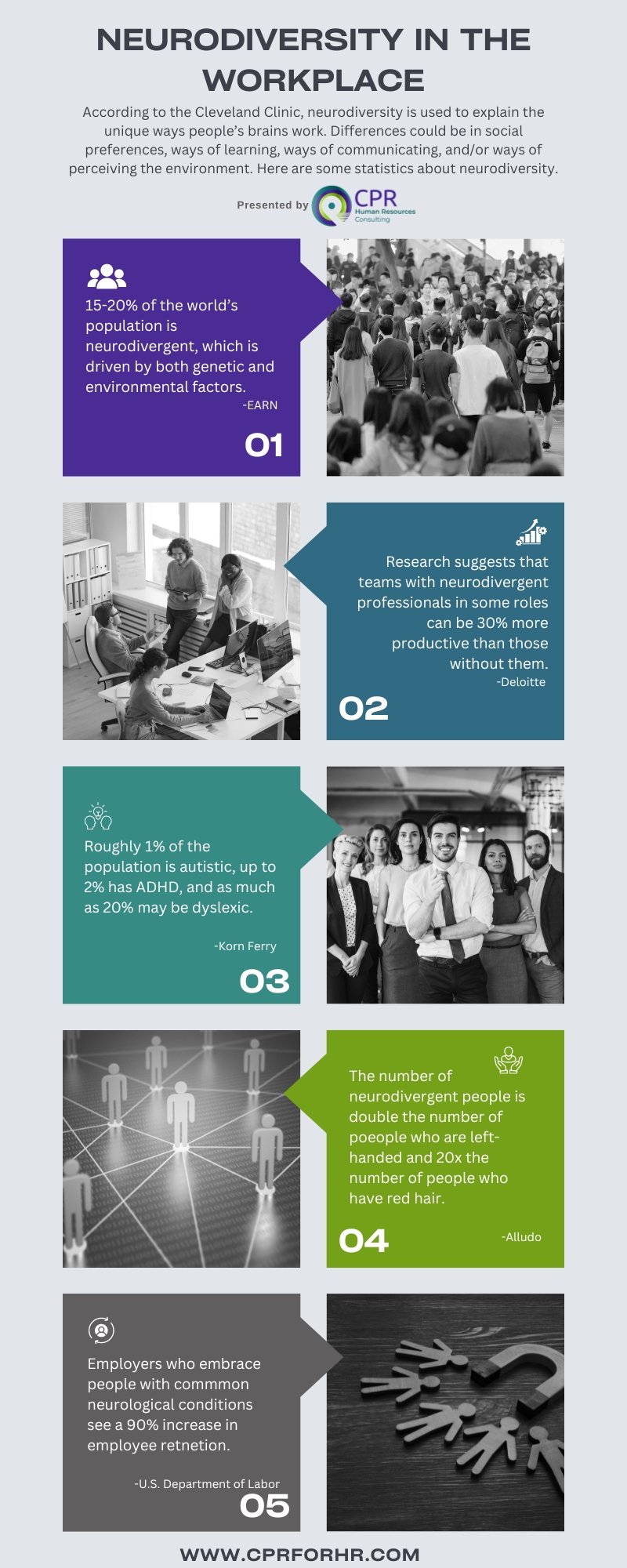Exploring Neurodiversity & 8 Ways to Foster a Neurodiverse Workplace – Part I
It's crucial for small businesses to recognize and embrace neurodiversity. However, recent studies have highlighted a concerning trend: according to a survey conducted by the Job Accommodation Network (JAN), 71% of U.S. workers reported that they had little to no awareness of neurodiversity in the workplace.
CPR believes it's essential for small businesses to understand and embrace neurodiversity to enhance the workplace by creating a more inclusive work environment and attract talent. In part I of this blog post, we'll explore what neurodiversity is and why it matters. In Part II we will explore how small businesses can foster greater awareness and acceptance of neurodiversity.
What is Neurodiversity?
Neurodiversity, a term coined by Judy Singer, an Australian sociologist in the late 1990s, refers to the natural variation in neurological characteristics and functioning. Neurodiversity encompasses a range of neurological differences that are natural and should be recognized and respected as part of human diversity, including:
Autism Spectrum Disorder (ASD)
Attention Deficit Hyperactivity Disorder (ADHD)
Dyslexia
Dyspraxia
Tourette Syndrome
Other cognitive variations
Studies estimate that about 15-20% of the population is neurodiverse; presumably, a small business with five employees has about one neurodiverse employee. Just as we celebrate diversity in race, gender, and ethnicity, neurodiversity acknowledges the unique strengths and perspectives that individuals with neurodivergent conditions bring to the table. Despite the prevalence of neurodivergent individuals in the workforce, studies have found that many employees lack awareness of neurodiversity and the challenges faced by neurodivergent individuals in the workplace.
Why Does Neurodiversity Matter?
Embracing neurodiversity in the workplace is not just about compliance or ticking boxes—it's about creating a culture of inclusivity, innovation, and belonging. Neurodivergent individuals often possess unique skills and perspectives that can contribute to organizational success, such as:
Pattern recognition
Out-of-the-box thinking
Attention to detail
Creativity
Problem-solving abilities
Hyperfocus on tasks of interest
Studies estimate that the unemployment rate for neurodivergent individuals is between 30-40%. By embracing neurodiversity, small businesses can tap into a broader talent pool, foster innovation, and creativity, improve overall employee engagement and satisfaction, and drive better business outcomes and productivity. Additionally, valuing neurodiversity enhances a company’s brand reputation as an inclusive and socially responsible employer, attracting top talent and increasing customer loyalty.
Conclusion
Small businesses cannot afford to overlook the importance of neurodiversity in today's fast-paced and competitive business environment. In Part I of this blog post we will discuss how small business owners can unlock the full potential of their diverse workforce through practical, actionable steps.
Neurodiversity in the Workplace
According to the Cleveland Clinic, neurodiversity is used to explain the unique ways people’s brains work. Differences could be in social preferences, ways of learning, ways of communicating, and/or ways of perceiving the environment. Please see the infographic to the left about neurodiversity.
Disclaimer: The information provided on this website does not, and is not intended to, constitute legal advice; instead, all information, content, and materials available on this site are for general informational purposes only. Information on this website may not constitute the most up-to-date legal or other information.

